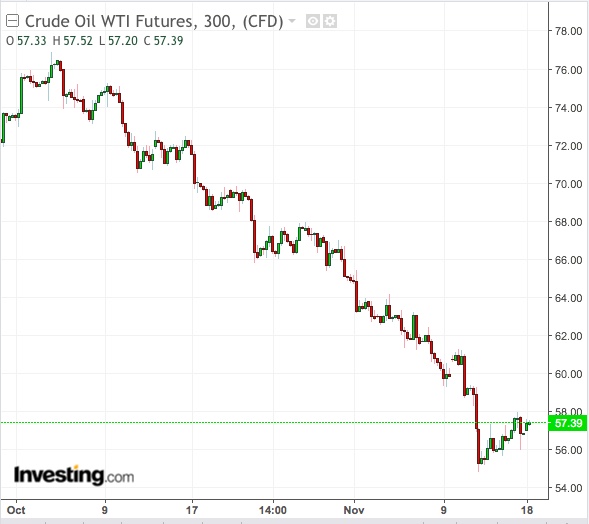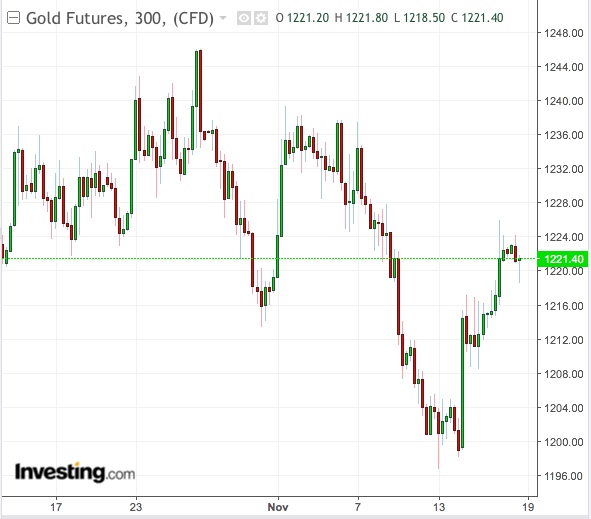Oil bears are expected to continue anxiously watching OPEC developments in this Thanksgiving-shortened week as the threat of production cuts hangs ominously over the market amid runaway builds in US crude inventory and uncertainty on whether the leaders of the US and China will reach a trade deal in the next two weeks.
Gold bugs may see a new lifeline at the $1,200 support as the Brexit crisis puts Europe into risk-off mode, with British Prime Minister Theresa May fighting for political survival while EU policymakers worry that further trouble could weigh on the UK's already fragile working relationship with the European Union.
In fact, financial markets across the world could be on tenterhooks, with a drop forecast in the Eurozone Consumer Confidence and Germany’s Manufacturing and Services PMI data likely to show flat growth at best. On the US side, while Housing Starts and Building Permits are expected to be positive, Durable Goods Orders data could show a decline.
Oil Bears May Be Queasy Building Shorts Pre-Holiday
As US markets gird for Thursday’s Thanksgiving holiday, selling pressure may ease for oil after a record bearish streak that culminated in six straight weeks of losses which erased some 25 percent off the market’s value. Fewer trading days could make oil bears leary of building shorts that may be difficult to unload in a sudden market flip, said analysts.
Dominick Chirichella of the Energy Management Institute in New York said:
“With the meeting coming up on December 6, OPEC has their work cut out for them to head into the meeting with upside price momentum.”
Saudi Arabia and the Organization of the Petroleum Exporting Countries (OPEC) have hinted they could agree on production cuts of up to 1.4 million barrels per day at their meeting in Vienna next month. That talk helped stop crude markets from posting an even worse loss than the 6 percent drop it suffered last week.
Oil Prices Off Lows, For Now
Chirichella said:
“With the US closed Thursday and low activity on Friday, the main positive for the oil complex is there will generally be less activity that will possibly quell some of the selling the market has seen over the last six weeks.”

Oil prices began Monday’s trade higher in Asia, with US West Texas Intermediate crude rising more than 1 percent to hover around $57.50 per barrel while Brent, the global benchmark for oil, climbed almost 1 percent to trade around $67.40. Still, that is about 25% lower from WTI’s four-year highs of nearly $77 hit in early October. Brent remains some 23% lower than last month's peak of nearly $87. The reversals were triggered by generous waivers issued on Iranian oil sanctions by President Trump, who initially vowed to bring crude exports by the Islamic Republic to zero.
And US crude inventories have jumped nearly 50 million barrels from eight weeks of uninterrupted builds, no thanks to refinery runs being at a lower-than-usual 90 percent—when runs closer to 100 percent are normal this time of year after seasonal maintenance cycles.
Swelling US Crude Stocks, China Worries Could Weigh On Prices
This suggests that physical buyers are holding out on taking more delivery of crude in the hope that prompt prices would fall further—signaling the six-week selloff may continue in some ways until the December 6 OPEC meeting.
Data also shows that US energy firms added oil rigs last week for a fifth time in six weeks, keeping the rig count at its highest in over three years.
That aside, investors will be glued to the meeting between US President Donald Trump and Chinese President Xi Jinping at the upcoming G-20 summit in Argentina for clues on whether the festering trade battle between the world’s two biggest economies will be resolved soon. Differences between the two sides were on full display at the summit of the Asia-Pacific Economic Cooperation (APEC) group over the weekend, where attendees failed to agree on a joint communique for the first time in its history. A projected slowdown in the Chinese economy next year is one reason for this year’s selloff in oil.
Gold Seeking To Buttress $1,200 Support With Brexit

Gold retreated in early Asian trading on Monday, with US futures of the yellow metal edging around 0.3% lower to under $1,220 per troy ounce after climbing 1.4 percent last week for its best gain in five weeks.
Initially resigned to losing the $1,200 support level as last week began, bullion’s fans managed to stay in their comfort zone as hedgers rushed to the relative safely of bullion after the pounding taken by sterling triggered by Brexit woes.
In the wake of her unpopular Brexit draft unveiled in the UK parliament last week, PM May has been battling to halt a growing revolt from the Tory right as half a dozen additional backbenchers came out in favor of a no-confidence vote against her, with signs more MPs would join this week. May was reported on Monday to be planning to promote her Brexit deal directly to business leaders to try and win approval for the plan.
Also providing some tailwinds to gold late last week were dovish comments by a few Federal Reserve speakers that cast some doubt on the central bank’s commitment to raise interest rates again next month, for the fourth time this year.
TD Securities said in a note on gold that while these factors provided short term support, speculators were still building short positions against the yellow metal. It added:
“We maintain the view that a fundamental shift in the strong dollar regime will be needed before gold can break materially higher.”
The Dollar Index, a contrarian bet to gold, was steady at 96.35 in Monday’s Asian trade, not far from the 16-month highs of 97.53 hit a week ago.
